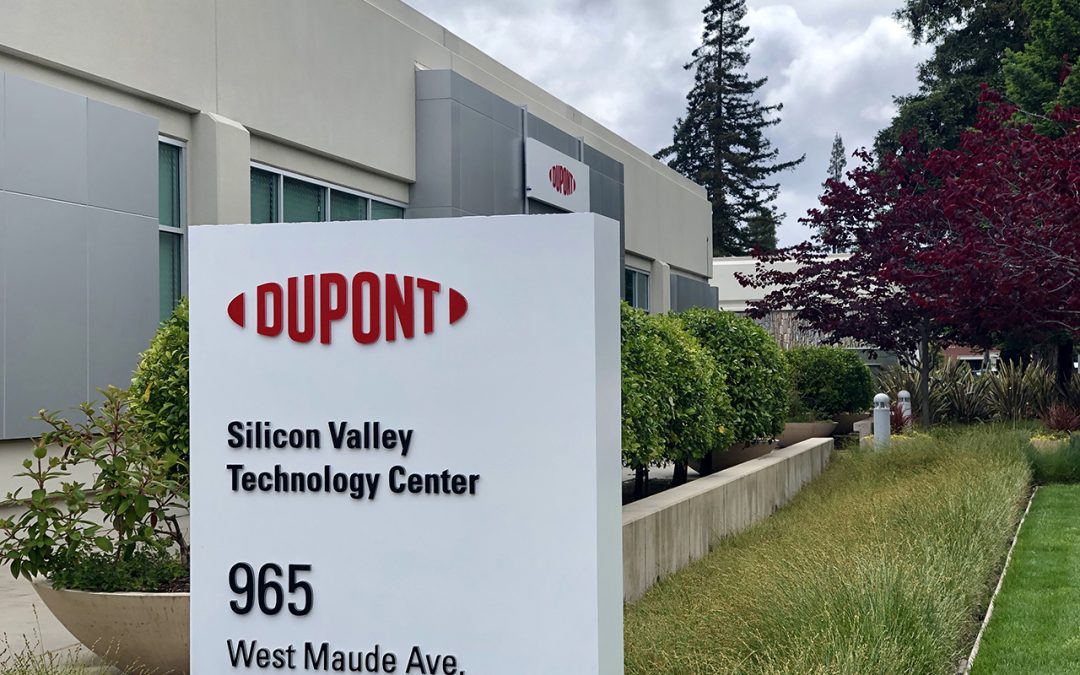 By Patricia Jacoby
By Patricia Jacoby
Senior Editor, Marketing
Frost & Sullivan
Introduction
On January 27, 2021, hosts Julian Velazquez, Innovation Center Leader and Nick Pugliano, New Business Development and CAE Leader, guided over sixty Growth Innovation and Leadership Council members, designees, and guests through the first Virtual DuPont Silicon Valley Technology and Innovation Center tour.
Currently, open in a restricted capacity, the Center is “a dynamic hub where visitors can explore cutting-edge technical applications in consumer electronics, EV/HEV/autonomous vehicles, 5G technologies, wearables, smart materials, and more.” The space is co-located in the DuPont Silicon Valley Technology Center (SVTC) in Sunnyvale, California and consists of an Application Center as well as office and meeting spaces.
The Center operates as a business unit within DuPont and is geared towards miniaturized electronic components. It is well-situated in the Bay area data and telecommunications community, especially as a primary Center goal is to drive high-speed data exploration. Accessing the mind of the engineer to create an environment where entrepreneurs of all kinds can mix and match ideas and create innovative solutions to challenging problems in hardware development” is another stated goal.
The Center combines business development with application labs, and is focused on materials development and solving for system-level challenges. Collaboration is a guiding principle as is rapid prototype ideation.
Product Portfolio
As detailed below, Innovation Center product portfolio focuses on 3 main businesses:
- Electronics and Imaging
- Transportation and Advanced Polymers
- Safety and Construction

Application Labs
Ten applications engineering laboratories are an integral part of the Innovation Center. All are equipped with fabrication equipment that enables rapid design and prototyping. As the Center’s site states: “The Labs are equipped to fit many Silicon Valley tech sectors’ needs, including rigid and flexible circuitry, next-generation displays, thermal management and printed electronics.”
As Julian Velazquez stated, the Center is a place to learn about DuPont and materials workshops; all of the labs are centered on materials, integration and ideation. The labs offer characterization instruments that support radio frequency and signal integrity, and mechanical, electrical, thermal, optical, and reliability applications.
As the Virtual Tour continued, Julian highlighted a few of his favorite labs. The first was the Characterization Lab, which examines characteristics of materials DuPont uses, and tests them for other possible applications. Julian discussed equipment that shows how materials react when exposed to water, further explaining that nature often provides inspiration for material design. An example of this can be found in examining the way flower petals shed water and then creating similar capabilities in a man-made material product. To do this, scientists and engineers used high-resolution optics and precise positioning to measure the contact angle where liquids meet solid.

The DuPont Reliability Lab tests reactions of materials and examines how they function through exercises like pulling material apart to see how durable it is. The Center is also home to a Radio Frequency (RF) Lab where engineers and visitors can study how materials react to RF capabilities. For instance, engineers and visitors can determine how materials react to different frequency waves and how they function; or how materials interfere differently with signal transmissions. Many of these experiments have or will lead to essential innovations.
As the presentation wrapped up and transitioned to a Q&A period, Richard Sear commented on how invaluable the glimpse into the Innovation Center was. He reminded Council members that Nurturing an Innovation Culture is one of the Critical Issues for study in 2021; making the Virtual Tour especially relevant. The Virtual Innovation Center tour and brief video included fascinating and very applicable take-aways for members.
Highlights of the member questions and answers fielded by Julian Velazquez, Innovation Center Leader and Nick Pugliano, New Business Development and CAE Leader can be found below:
Q&A
Does your company expect an ROI from the Center?
The Center is more about collaboration, sharing credit and tracking “design wins.” They take a big picture approach and focus on hyper-connected teamwork, working on problems together and growth overall.
Water (clean, or lack of) is a global problem. Do you work on water filtration and treatment issues?
Water is a big focus for DuPont and they are working on water sustainability and other related issues.
What is the innovation process at the Center like?
There are multiple innovation processes. Overall, we focus on open innovation. The Center is designed to facilitate innovation led by industry leaders, partners and others. We seek to encourage connections, discoveries and creativity.
We also host workshops and encourage others to work with our on-site experts.
Another focus is on digital experimentation, i.e. digital transformation projects. We are building digital libraries too.
How is the Innovation Center organized?
Approximately 85% of the projects come from the Silicon Valley area; the remaining 15% are global.
What is your dream for the Innovation Center? Right now ? 5-10 years out?
We would like to be able to quickly make digital prototypes and continue to extend innovation to the rest of DuPont. We want to continue to follow “the art of the possible,” to demonstrate and learn about the miniaturization process every day, and to stay relevant to customers.



Recent Comments